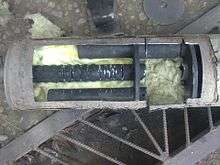Muffler


A muffler (silencer in British English) is a device for reducing the noise emitted by the exhaust of an internal combustion engine.
History
The US Patent for an ‘Exhaust muffler for engines’ was awarded to Milton O. Reeves and Marshall T. Reeves of Columbus, Indiana of the Reeves Pulley Company on 11 May 1897. US Patent Office application № 582485 states that they “have invented certain new and useful Improvements in Exhaust-Mufflers for engines”.[1]
Description
Mufflers are installed within the exhaust system of most internal combustion engines. The muffler is engineered as an acoustic device to reduce the loudness of the sound pressure created by the engine by acoustic quieting. The noise of the burning-hot exhaust gas exiting the engine at high velocity is abated by a series of passages and chambers lined with roving fiberglass insulation and/or resonating chambers harmonically tuned to cause destructive interference, wherein opposite sound waves cancel each other out.
An unavoidable side effect of this noise reduction is restriction of the exhaust gas flow, which creates back pressure, which decreases engine efficiency. This is because the engine exhaust must share the same complex exit pathway built inside the muffler as the sound pressure that the muffler is designed to mitigate.

Some aftermarket mufflers claim to increase engine output and/or reduce fuel consumption by dint of reduced back pressure. This usually entails less noise reduction (i.e., more noise). The legality of altering a motor vehicle's original equipment exhaust system varies by jurisdiction; in many developed countries such as the United States,[2] Canada,[3], and Australia, [4] such modifications are highly regulated or strictly prohibited.
Aftermarket mufflers usually alter the way vehicle performs due to back pressure decrease[5].
Paradoxically, some cars are so quiet that manufacturers deliberate generate engine sound to give the driver audio feedback on the engine.[6]
See also
References
- ↑ "Exhaust Muffler For Engines Muffler Patent". Google. Retrieved 22 June 2014.
- ↑ https://www.fmcsa.dot.gov/regulations/title49/section/325.91
- ↑ http://www.bclaws.ca/Recon/document/ID/freeside/26_58_04
- ↑ http://www.epa.nsw.gov.au/noise/vehiclenoise.htm
- ↑ D. W. Herrin (2012). "Vibro-Acoustic Design in Mechanical Systems" (PDF). University of Kentucky.
- ↑ Viex, Joe (10 September 2018). "What's a car supposed to sound like?". The Outline (website). Retrieved 11 September 2018.
External links
| Wikimedia Commons has media related to Exhaust silencers. |